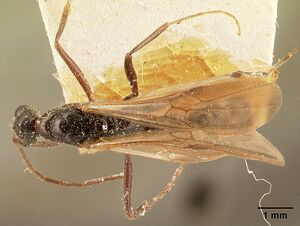Leptogenys saussurei
| Leptogenys saussurei | |
|---|---|

| |
| Scientific classification | |
| Kingdom: | Animalia |
| Phylum: | Arthropoda |
| Class: | Insecta |
| Order: | Hymenoptera |
| Family: | Formicidae |
| Subfamily: | Ponerinae |
| Tribe: | Ponerini |
| Genus: | Leptogenys |
| Species group: | saussurei |
| Species: | L. saussurei |
| Binomial name | |
| Leptogenys saussurei (Forel, 1891) | |
Leptogenys saussurei forages terrestrially, and can be found on the forest floor and in leaf litter. It nests in rotten logs and dead branches on the ground.
Identification
A member of the saussurei species group. Rakotonirina and Fisher (2014) - Worker. Mandible elongate and robust, capable of closing tightly against clypeus; anterior clypeal margin medially projecting into triangular lobe; anterior clypeal margin medially projecting into triangular lobe; clypeus with sharp edge or lamella. Eye large, diameter markedly greater than maximum width of antennal scape. Dorsum of head and mesosoma distinctly sculptured; with mesosoma in dorsal view, metanotal groove distinctly visible. In dorsal view, posterior margin of petiolar node medially emarginate.
Leptogenys saussurei is one of the largest species in the group. As in Leptogenys acutirostris and Leptogenys lohahela, it has a visible metanotal groove, but the posterior margin of the petiolar node is not medially excised in L. saussurei as it is in these two species.
Keys including this Species
Distribution
Madagascar. One of the most widely distributed species in the saussurei group, L. saussurei ranges from RS Ambatovaky in the north to the PN Andohahela in the south. Between these two sites, the species has been recorded from the rainforest of the PN Mantadia and RS Manombo to the montane rainforest of the RS Ivohibe.
Distribution based on Regional Taxon Lists
Malagasy Region: Madagascar (type locality).
Distribution based on AntMaps
Distribution based on AntWeb specimens
Check data from AntWeb
Countries Occupied
| Number of countries occupied by this species based on AntWiki Regional Taxon Lists. In general, fewer countries occupied indicates a narrower range, while more countries indicates a more widespread species. |

|
Estimated Abundance
| Relative abundance based on number of AntMaps records per species (this species within the purple bar). Fewer records (to the left) indicates a less abundant/encountered species while more records (to the right) indicates more abundant/encountered species. |

|
Biology
|
Castes
The thorax of ergatoid queens in L. saussurei is extremely simplified, with sclerites almost similar to workers'
Male
Images from AntWeb
   
| |
| Male (alate). Specimen code casent0101963. Photographer April Nobile, uploaded by California Academy of Sciences. | Owned by MHNG, Geneva, Switzerland. |
Nomenclature
The following information is derived from Barry Bolton's Online Catalogue of the Ants of the World.
- saussurei. Lobopelta saussurei Forel, 1891b: 121 (w.) MADAGASCAR. Forel, 1891b: 218 (m.). Combination in Leptogenys: Emery, 1911d: 102. See also: Bolton, 1975a: 297.
Unless otherwise noted the text for the remainder of this section is reported from the publication that includes the original description.
Description
Worker
Rakotonirina and Fisher (2014) - (8 specimens). HW: 1.42–1.75, HL: 1.92–2.44, CI: 71–78, SL: 1.80–2.59, SI: 126–148, PW: 1.27–1.57, WL: 3.04–3.80, PNH: 1.21–1.47, PNL: 1.02–1.22, PNW: 0.96–1.21, DNI: 92–105, LNI: 118–132.
Head elongate, sides broadly convex but slightly converging posteriorly from level of eye. Clypeus projecting anteriorly into non-bidentate triangular median lobe. Lamellate extension of inner mandibular margin widest at distal third, from which first preapical tooth is followed by another, closer blunt angle before rising into sharp apical tooth. With mesosoma in profile, mesopleural sulcus incomplete or absent; in dorsal view metanotal groove distinctly visible. With petiole in dorsal view, node longer than broad, with markedly excised posterior margin; in side view, posterolateral margin armed with one sharp tooth. Anterior portion of head from base of mandible to level of eye reticulate-rugose, interspersed with punctures. In full-face view, dorsum of head behind level of anterior margin of eye with dense punctures, which become larger and widely spaced towards its posterior margin. Mandible finely striate between sparse punctures. In dorsal view, pronotum punctate, remainder of mesosoma with scattered punctures. Petiolar node sparsely punctate, faint striation or rugoreticulum may be present on upper half of lateral section. Gastral segments mostly smooth and shining. Body with bluish reflection.
Type Material
Rakotonirina and Fisher (2014) - Holotype worker, Madagascar, Mahanoro, côte Est de Madagascar (de Saussure) (Musee d'Histoire Naturelle Genève) AntWeb specimen code: CASENT0101805 [examined].
References
- Bolton, B. 1975a. A revision of the ant genus Leptogenys Roger (Hymenoptera: Formicidae) in the Ethiopian region with a review of the Malagasy species. Bull. Br. Mus. (Nat. Hist.) Entomol. 31: 235-305 (page 297, see also)
- Emery, C. 1911e. Hymenoptera. Fam. Formicidae. Subfam. Ponerinae. Genera Insectorum 118: 1-125 (page 102, Combination in Leptogenys)
- Forel, A. 1891c. Les Formicides. [part]. In: Grandidier, A. Histoire physique, naturelle, et politique de Madagascar. Volume XX. Histoire naturelle des Hyménoptères. Deuxième partie (28e fascicule). Paris: Hachette et Cie, v + 237 pp. (page 121, worker described; page 218, male described)
- Rakotonirina, J.C. & Fisher, B.L. 2014. Revision of the Malagasy ponerine ants of the genus Leptogenys Roger (Hymenoptera: Formicidae). Zootaxa 3836, 1-163.
References based on Global Ant Biodiversity Informatics
- Fisher B. L. 1997. Biogeography and ecology of the ant fauna of Madagascar (Hymenoptera: Formicidae). Journal of Natural History 31: 269-302.
- Fisher B. L. 2003. Formicidae, ants. Pp. 811-819 in: Goodman, S. M.; Benstead, J. P. (eds.) 2003. The natural history of Madagascar. Chicago: University of Chicago Press, xxi + 1709 pp.
- Rakotonirina J. C., and B. L. Fisher. 2014. Revision of the Malagasy ponerine ants of the genus Leptogenys Roger (Hymenoptera: Formicidae). Zootaxa 3836 (1): 001163.
- Wheeler W. M. 1922. Ants of the American Museum Congo expedition. A contribution to the myrmecology of Africa. IX. A synonymic list of the ants of the Malagasy region. Bulletin of the American Museum of Natural History 45: 1005-1055



